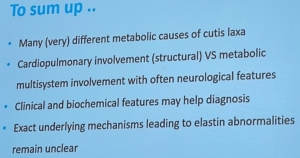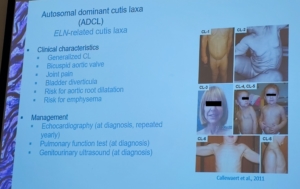Distribution of CL according to Types and Countries
Our census of Cutis Laxa patients allows today to establish
its breakdown by known types and also by countries
You can find here the table updated on 2024, February 12th
Our census of Cutis Laxa patients allows today to establish
its breakdown by known types and also by countries
You can find here the table updated on 2024, February 12th
The “Patient Journey” seeks to identify the needs that are
specific to individual syndromes. To achieve this, patient
representatives completed a mapping exercise of the needs
of each rare inherited syndrome they represent, across the
different stages of the Patient Journey.
This is the definition of the Patient Journey as mentioned in this article published in 2019.
This is an important work and we established the Cutis Laxa “Patient Journey”.
Cutis Laxa being such a complex disorder, with several subtypes and various associated symptoms, we could not have just one Cutis Laxa “Patient Journey”. We gathered together associated symptoms of the different subtypes and ended with two groups of subtypes.
Here are the results for the two “Patient Journeys” for Cutis Laxa patients:
Adamo et al. describe a cutis laxa syndrome caused by bi-allelic loss of-function variants in EMILIN1 characterized by arterial tortuosity, aneurysm formation, and osteopenia. They provide a model in which EMILIN1 connects elastic fiber network with collagen fibril formation, relevant for both bone and vascular tissue homeostasis.

Cutis Laxa disorders usually present cardiovascular issues that need a specific follow up.

Various devices can be used such as echocardiography, CT-Scan and MRI.


Each one of those devices has its pros and cons and must be chosen according to what is examined.


This new classification will simplify the diagnostic process and identify relevant Cutis Laxa subgroups with regard to management and clinical research.

In addition, identification of the underlying genetic defect may end the diagnostic odyssey, further stratify management, and may provide (im)partial answers to future health issues.

Furthermore, it provides answers to potential recurrence risks in the offspring of patients and relatives as well as the use of diverse reproductive options.

Finally, connecting with peers provides support and encourages participation into patient-centered research aiming at a better quality of life and-hopefully- more directed therapeutic options.


The best known function of mithocondria is energy production (ATP synthesis) via the respiratory chain.


However, this organelle is also central in several metabolic processes like the tricarboxylic acid (TCA) cycle, the urea cycle and important for cellular stress response processes and programmed cell death.


This presentation will focus on the clinical differences between and within the single entities, discussed in relation to known and novel findings from cellular and animal models.

By this, an overview about the research on the mitochondria related cutis laxa disorders will be given.
The underlying molecular defects in Cutis Laxa Sybdromes can also be roughly divided in two groups,

based on type of involved pathomechanism : defects in genes coding a « structural » ECM-component or in genes in which mutations can inborn errors of metabolism (IEM) presenting with Cutis Laxa.


The exact way these divergent molecular lead to elastin abnormalities remain unclarified.


Secreted proteins and membrane proteins have to pass through the secretory pathway, which is not only responsible for the transport to the correct cellular compartment, but also for the maturation and modification of these proteins. A central part of the secretory pathway is the Golgi compartment, which consists of several « pancake-like » membrane sacks (cisternae).


One important modification is glycosylation, which has been found altered in a whole group of Cutis Laxa disorders, that are also named congenital disorders of glycosylation (CDG).


Elastic fiber assembly, or elastogenesis, is a complex process that is precisely regulated in a spatiotemporal manner and depends on proper growth factor signaling and mechanosensing.


The underlying molecular defect in cutis laxa syndromes affect the synthesis and/or association associated extracellular matrix proteins.




Understanding how the fine tune mechanisms of elastic fibers formation is perturbed in the different types of Cutis Laxa is crucial to design molecular therapies in preclinical trials using animal models.


This site uses cookies. By continuing to browse the site, you are agreeing to our use of cookies.
OKLearn moreYou can read about our cookies and privacy settings in detail on our Privacy Policy Page.
Privacy Policy